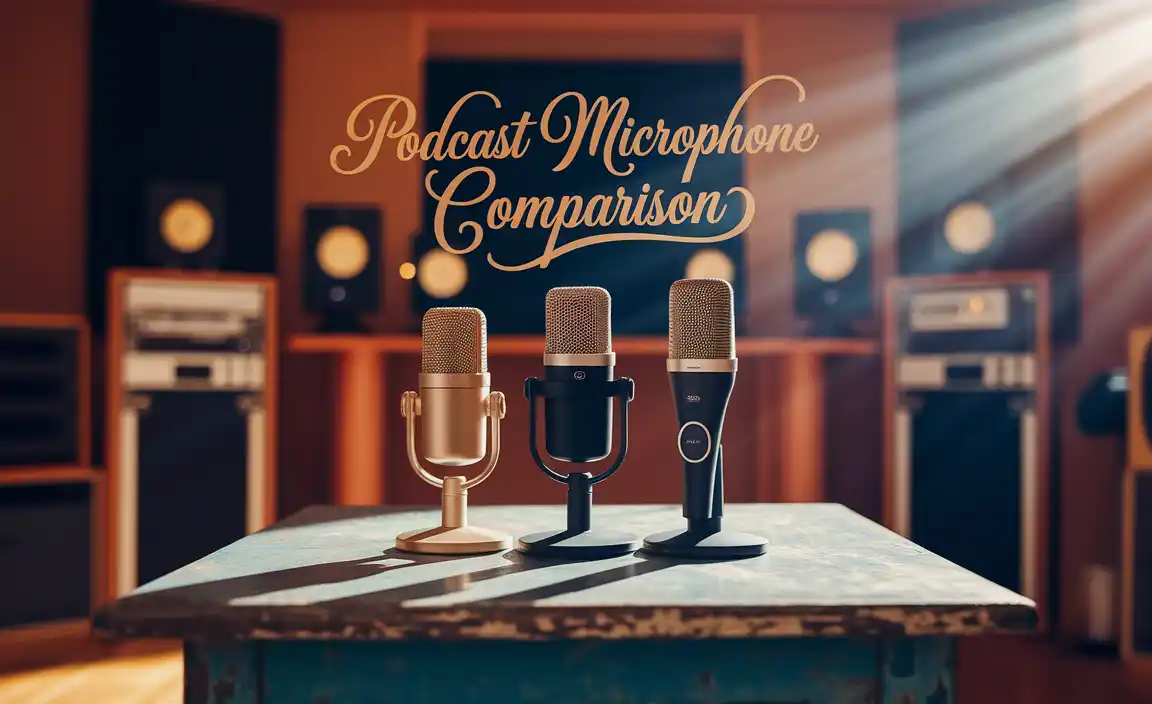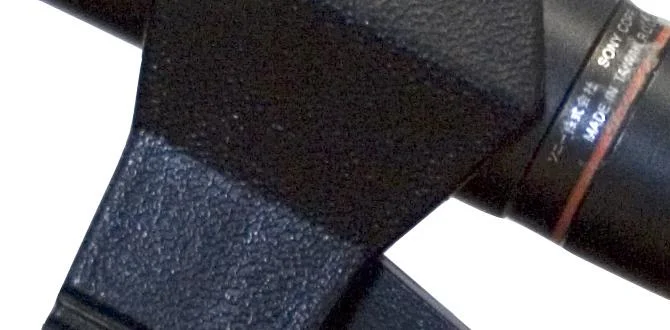Quick Summary:
Confused by contrast ratios on budget TVs? A good contrast ratio makes darks darker and brights brighter, boosting picture quality. For cheap TVs, aim for anything above 1000:1 static contrast, and focus on reviews for actual “dynamic” performance, as marketing numbers can be misleading. This guide simplifies it all!
Picking out a new TV can feel like navigating a maze, especially when you’re trying to stick to a budget. You see terms like “contrast ratio” thrown around, and it’s easy to get lost in the tech talk. What exactly is it, and how important is it when you’re shopping for an affordable TV? Don’t worry, I’ve got your back. This guide will break down contrast ratio in simple terms, so you can make a smart choice without breaking the bank. We’ll look at what numbers really matter, what to watch out for, and how to get the best picture possible on your next cheap TV. Let’s dive in and make sure you’re not missing out on stunning visuals!
Understanding Contrast Ratio: Your TV’s Secret Weapon
Think of your TV screen like a canvas. Contrast ratio is basically the difference between the brightest white and the darkest black your TV can show at the same time. A higher contrast ratio means you get much deeper blacks and brighter whites, creating a more vibrant, lifelike image with more detail in both the shadows and the bright spots. It’s a really key factor in how good a picture looks, especially in darker scenes. Without good contrast, dark areas can look washed out and gray, and bright areas might lack punch. For anyone who loves movies, sports, or gaming, a strong contrast ratio makes a noticeable difference.
Why Contrast Ratio Matters, Even on a Budget
You might think that fancy contrast ratios are only for expensive TVs, but that’s not entirely true. Even on a budget-friendly set, contrast ratio plays a huge role in the overall viewing experience. A TV with a poor contrast ratio will struggle to show deep blacks, making dark scenes in movies appear more like shades of gray. This takes away from the immersion and can hide important details. On the flip side, a TV with a decent contrast ratio can make colors pop, improve depth perception, and make text more readable. For everyday viewing, from watching the news to your favorite streaming shows, better contrast means a more enjoyable picture.
The good news is that manufacturers are constantly improving their technology. This means that even some of the more affordable TVs on the market today offer surprisingly good contrast ratios. The challenge is knowing which numbers to trust and what to look for. We’ll help you cut through the marketing hype and focus on what truly delivers a better picture for your money.
Static vs. Dynamic Contrast Ratio: What’s the Real Deal?
This is where things can get a little confusing, and it’s a crucial point when looking at cheap TVs. You’ll often see two numbers for contrast ratio: static and dynamic. They’re not the same, and one is much more honest than the other.
Static Contrast Ratio: The Honest Number
The static contrast ratio is the most reliable measurement. It tells you the difference between the brightest white and the darkest black that the TV can display simultaneously in a single, unchanging image. This is a true representation of the panel’s capability. It’s usually a much lower number than the dynamic contrast ratio.
As a general rule, for a decent static contrast ratio on a budget TV, you’ll want to look for numbers above 1000:1. Many modern TVs, even affordable ones, can achieve this. For example, a static contrast ratio of 1000:1 means that the brightest white the screen can produce is 1000 times brighter than the darkest black it can produce at the same instant.
Dynamic Contrast Ratio: The Marketing Trick
The dynamic contrast ratio is a number that manufacturers often use in their marketing. It’s calculated by measuring the brightest white and darkest black the TV can produce over a period of time, not at the same instant. This is often achieved by the TV dynamically adjusting its backlight or brightness. While it can make a picture look more impactful for certain scenes, it’s not a true reflection of the panel’s inherent contrast capability at any given moment.
“Huge dynamic contrast ratios, like 1,000,000:1 or more, are generally not very useful for consumers trying to compare true display performance,” says the expert team at Rtings.com, a reputable TV review site. “They often rely on aggressive frame control or local dimming… which can introduce other artifacts.”
When you see a TV advertised with a massive dynamic contrast ratio but a very low static one, it’s a sign to be skeptical. For budget TVs, always prioritize the static contrast ratio, or look at independent reviews that test for real-world contrast performance.
What to Look for in Cheap TV Contrast Ratio: Practical Tips
So, how do you actually find a good contrast ratio without overspending? It’s all about knowing where to focus your attention and what to ignore.
Focus on Static Contrast: Your Best Friend
As we’ve discussed, the static contrast ratio is your most reliable guide. When you’re browsing specs for a budget TV, look for this number. While specific recommendations can vary with technology, a static contrast ratio of 1000:1 is generally considered the minimum for watchable performance.
The higher, the better. If you can find a budget TV with a static contrast ratio of 2000:1 or 3000:1, that’s even better and will likely offer a more impactful picture. Technologies like VA (Vertical Alignment) panels tend to offer better native static contrast than IPS (In-Plane Switching) panels, though IPS panels often have better viewing angles. For a primarily single-viewer setup in a darker room, a VA panel might be a good compromise for deeper blacks.
Read Independent Reviews: The Real-World Test
Marketing numbers can be misleading. This is why turning to trusted, independent review sites is essential, especially for budget-friendly TVs. Sites like Rtings.com, CNET, and TechRadar conduct rigorous tests and measure actual performance. They’ll tell you the real static contrast ratio and often describe how well the TV handles dark scenes, with or without local dimming features.
When reading reviews, look for:
- Actual measured static contrast ratios.
- Descriptions of black levels and shadow detail.
- Comments on how the TV performs in dark rooms.
- Comparisons to other TVs in the same price range.
These real-world insights are invaluable. They can confirm if a TV’s specs translate into a good viewing experience or if those impressive dynamic numbers are just smoke and mirrors.
Understand Panel Technology Differences
The type of LCD panel used in your TV significantly impacts contrast. While OLED TVs offer infinite contrast (meaning they can turn pixels completely off for true black), they are typically outside the “cheap TV” bracket. For budget TVs, you’re mostly looking at LCD technology.
LCD Panel Types and Contrast
Here’s a simple breakdown:
- VA (Vertical Alignment) Panels: Generally offer better native contrast ratios than IPS panels. They excel at producing deeper blacks. However, they can sometimes have narrower viewing angles and slower response times, which might lead to motion blur for fast-moving content.
- IPS (In-Plane Switching) Panels: Typically provide wider viewing angles and better color accuracy, making them good if you have a wide seating arrangement. However, their native contrast ratios are usually lower, meaning blacks can appear grayer.
For a budget TV focused on good contrast, a VA panel is often the preferred choice, assuming viewing angles aren’t your absolute top priority. Some newer technologies aim to bridge this gap, but for the most part, this distinction holds true in the budget segment.
Look for Local Dimming (with Caution)
Some TVs, even at lower price points, might feature “local dimming.” This technology allows specific zones of the LED backlight to be dimmed or brightened independently. This can significantly improve contrast and black levels.
However, the effectiveness of local dimming varies greatly. Cheaper TVs might have only a few dimming zones, which can lead to “blooming” (a halo effect around bright objects on dark backgrounds) or a less uniform picture. The more zones a TV has, the better it can control contrast locally. If a budget TV boasts local dimming, check reviews to see how well it’s implemented. Sometimes, a TV without local dimming but with a good native contrast panel might still offer a more pleasing image than one with poorly executed local dimming.
Consider Viewing Environment
Your room’s lighting conditions play a big part in how you perceive contrast ratios. If you plan to watch TV in a bright room, the impact of deep black levels will be less noticeable, and good brightness might be more important. In a dark room, however, superior contrast ratios will really shine, making the image much more immersive and detailed.
For a budget TV intended for a bright living room, you might sacrifice a tiny bit of ultimate black depth for a screen that can get brighter and combat reflections. If you’re setting up a TV in a basement media room or often watch in the evening, prioritizing static contrast ratio and deep blacks will give you the most bang for your buck.
Comparing Contrast Ratios: A Simple Table
To help you visualize what’s generally considered good, acceptable, or poor for contrast ratios on budget TVs, here’s a simplified comparison. Remember, these are general guidelines, and independent reviews are always the best source for specific model performance.
| Contrast Ratio (Static) | Picture Quality for Budget TVs | Notes |
|---|---|---|
| 100:1 – 500:1 | Poor | Expect washed-out blacks and low detail in dark scenes. Generally found on very old or extremely low-end models. |
| 500:1 – 1000:1 | Acceptable/Basic | A common range for many budget TVs. Watchable, but dark scenes might lack depth. |
| 1000:1 – 2000:1 | Good | This is a solid target for a budget TV. Offers noticeably better black levels and depth. |
| 2000:1+ | Very Good | Excellent for a budget TV. Look for reviews to see how it performs in real-world use. Often found on higher-end budget models or those with effective local dimming. |
Remember, these figures are for static contrast. Dynamic contrast numbers will be vastly higher and less informative for comparison.
Beyond Contrast Ratio: Other Factors for a Great Cheap TV
While contrast ratio is a crucial aspect of picture quality, it’s not the only thing you should consider when buying a budget TV. Several other factors contribute to the overall viewing experience and can often be prioritized depending on your needs.
Resolution (HD, Full HD, 4K)
Resolution refers to the number of pixels on the screen. More pixels mean a sharper, more detailed image. For a modern TV, 4K (Ultra HD) is the standard and offers a significant upgrade in detail over Full HD (1080p). Even on a budget, you can find many excellent 4K TVs.
- 4K (3840 x 2160 pixels): The current standard. Provides a very detailed picture, especially on larger screens.
- Full HD (1920 x 1080 pixels): Still acceptable for smaller screen sizes (under 40 inches) or if your budget is extremely tight.
- HD Ready (1280 x 720 pixels): Generally too low a resolution for modern TVs unless you’re buying a very small secondary TV or something for a workshop.
When buying a cheap TV, aim for 4K resolution if at all possible. The difference in sharpness is substantial and makes content look much better.
HDR (High Dynamic Range) Support
HDR content is mastered to take advantage of displays with a wider range of color and contrast—essentially, better HDR support means a TV that can display brighter brights and darker darks, with a broader spectrum of colors. This makes the image pop with more realism and detail. Look for support for HDR10, the most common HDR format. Some TVs might also support Dolby Vision.
Even on cheaper TVs, basic HDR support can make a difference. However, the quality of HDR implementation varies greatly. A TV with a low contrast ratio and limited peak brightness won’t be able to fully display the benefits of HDR content. Check reviews to see how well a budget TV handles HDR.
Refresh Rate
The refresh rate, measured in Hertz (Hz), tells you how many times per second the image on the screen is updated. A higher refresh rate (like 120Hz) results in smoother motion, which is particularly important for fast-paced content like sports, action movies, and video games.
Most budget TVs will have a native refresh rate of 60Hz. While this is sufficient for general viewing, some may advertise higher “motion rates” or “effective refresh rates” (e.g., 120 or 240). These are often marketing terms and not indicative of a true 120Hz panel. For budget TVs, native 60Hz is common and perfectly fine for most users. If gaming or sports are a priority, try to find out the native refresh rate if possible, but don’t overspend if it means sacrificing contrast or resolution.
Smart TV Features and Operating System
Most modern TVs are “smart TVs” with built-in internet connectivity and apps like Netflix, YouTube, Hulu, etc. The user interface and the range of available apps can vary significantly between brands and models. Some popular operating systems include Google TV (Android TV), Roku TV, webOS, and Tizen.
For a budget TV, the smart platform might be more basic. Ensure it has the streaming apps you use most frequently. If the built-in smart features are clunky or limited, you can always add an external streaming device like a Roku stick or Amazon Fire TV stick, which often offer a better user experience anyway.
Connectivity (HDMI Ports)
Check how many HDMI ports the TV has. Most people will need at least two or three for devices like game consoles, Blu-ray players, soundbars, or streaming sticks. Ensure the HDMI ports support the latest standards if you have newer devices, though for a budget TV, basic HDMI 2.0 is usually sufficient.
How to Evaluate a Cheap TV’s Contrast Ratio When Buying
When you’re standing in the store or browsing online, how can you best assess a TV’s contrast ratio, especially when the marketing numbers seem inflated?
Step-by-Step Evaluation
- Check the Specs Carefully: Look for the “Static Contrast Ratio.” If it’s not listed or only “Dynamic Contrast Ratio” is shown, be wary. Aim for 1000:1 or higher for static contrast.
- Ignore Wildly High Dynamic Numbers: Numbers like 1,000,000:1 or more are almost always marketing exaggeration and not indicative of true performance.
- Seek Out Independent Reviews: This is your most powerful tool. Websites like Rtings.com provide detailed measurement data for contrast, black uniformity, and overall picture quality for many TV models, including budget ones.
- Look for Panel Type Information: If possible, identify if








